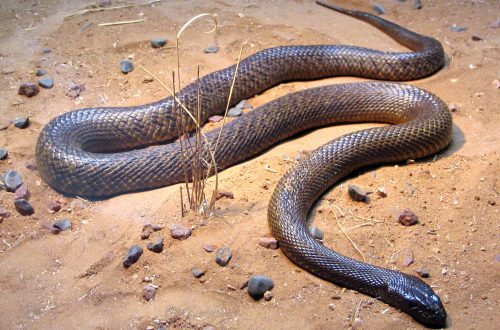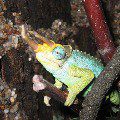
Chameleon Jackson
This creature, due to its amazing qualities, is easily considered an alien from another planet. And it seems that it is fully aware of its exclusivity – this is evidenced by the noble and even slightly arrogant expression of the muzzle of the animal. If you have not guessed yet, we are talking about a chameleon, the most important and unusual gift of which is the ability to change color. However, it is not entirely correct to assume that in this case the entire existing spectrum of colors is available to the chameleon at any time. The color change of the animal depends on many factors – mood, well-being, ambient temperature and other conditions. Well, its aristocratic appearance is explained by the structure of the eyes, which are covered with eyelids and have another unusual property – to look in different directions.
Contents
Classification
Kingdom: Animals
Type: Chord
Class: Reptiles
Order: Scaly
Suborder: Lizards
Family: Chameleons
Genus: Real chameleons
Species: Jackson’s Chameleon Chamaeleo jacksonii
Cj jacksonii, Cj merumontanus, Cj xantholophus
Appearance
 When it comes to horns, most of us for some reason remember artiodactyls, and some lizards endowed with this sign are undeservedly overlooked. And Jackson’s chameleon is one of them. True, only males of this species have horns in the amount of three. They are two cone-shaped outgrowths located next to the eyes and a third, coming straight from the tip of the nose. In females, the nasal horn is noticeably smaller, and the two lateral ones are sometimes not developed at all. And in young males, horns appear a couple of months after birth. In addition to them, there is a horny comb on the back of the head of Jackson’s chameleons, which then turns into a wave strip of skin along the back. The tenacious tail of lizards is equal to half the length of their body. The scutes of the scales are of different sizes – the largest ones cover the head and crest. The body dimensions of the Jackson Chameleons are about 40 cm in males, 25 cm in females.
When it comes to horns, most of us for some reason remember artiodactyls, and some lizards endowed with this sign are undeservedly overlooked. And Jackson’s chameleon is one of them. True, only males of this species have horns in the amount of three. They are two cone-shaped outgrowths located next to the eyes and a third, coming straight from the tip of the nose. In females, the nasal horn is noticeably smaller, and the two lateral ones are sometimes not developed at all. And in young males, horns appear a couple of months after birth. In addition to them, there is a horny comb on the back of the head of Jackson’s chameleons, which then turns into a wave strip of skin along the back. The tenacious tail of lizards is equal to half the length of their body. The scutes of the scales are of different sizes – the largest ones cover the head and crest. The body dimensions of the Jackson Chameleons are about 40 cm in males, 25 cm in females.
And, finally, the most important feature of the family – the ability to change color – these lizards are quite limited. Their permanent shade is greenish-yellow. Usually, the chin of the Jackson chameleon is yellow, and a wide green stripe runs along the side. When frightened or showing aggression, males can dress in jet black with green or brown spots, while females more often take on brown or black and white shades, but natural green is extremely rare for them. This color variability for Jackson’s chameleons is not only a means of disguise, but also a special language in which the lizards communicate with each other.
The structure of the skin of this type of chameleon is also extremely unusual. Soft and pleasant to the touch, from the outside it gives the impression of a rough, tree-like skin. Zoologists often compare the scales of lizards to the skin of ancient dinosaurs.
As for species differences, they also have a place to be. In particular, the panther chameleon has a much wider range of colors, can turn bright red or be painted in other catchy tones. However, Jackson’s chameleons are more prone to camouflage than to simple color changes, so all of their shades are mostly close to natural. So these lizards fool enemies – predators and hunters.
Distribution and habitation
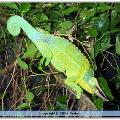 Jackson’s chameleons are residents of East Africa, in particular, its areas such as Kenya, Tanzania and Nairobi. They are also found in the Hawaiian Islands, however, lizards were artificially introduced there. These chameleons live in trees, and they are able to climb quite high – up to 10 meters above the ground. They can be found in the forests of Nairobi at an altitude of 1600-2200m above sea level, in the mountains and foothills of Kenya and Tanzania. And sometimes they take root in low shrub groves. As for the climatic conditions suitable for Jackson’s chameleons, they prefer warm areas with high humidity and try to stick to certain areas of habitat. For example, a typical subspecies of this lizard is most often found in the vicinity of Nairobi near the middle elevation of Mount Kenya, climbing to a height of 1500 to 2440 m. The yellow-crested chameleon Ch.jacksonii xantholophus has taken root on the middle and high slopes in the south and east of the same mountain , at an altitude of 1830 to 2440 m. This lizard was once brought to the United States, where it lives to this day. The range of the third subspecies Chamaeleo jacksonii merumontanus is limited to the region of Tanzania, in particular, the area near Mount Meru, on its middle and high slopes.
Jackson’s chameleons are residents of East Africa, in particular, its areas such as Kenya, Tanzania and Nairobi. They are also found in the Hawaiian Islands, however, lizards were artificially introduced there. These chameleons live in trees, and they are able to climb quite high – up to 10 meters above the ground. They can be found in the forests of Nairobi at an altitude of 1600-2200m above sea level, in the mountains and foothills of Kenya and Tanzania. And sometimes they take root in low shrub groves. As for the climatic conditions suitable for Jackson’s chameleons, they prefer warm areas with high humidity and try to stick to certain areas of habitat. For example, a typical subspecies of this lizard is most often found in the vicinity of Nairobi near the middle elevation of Mount Kenya, climbing to a height of 1500 to 2440 m. The yellow-crested chameleon Ch.jacksonii xantholophus has taken root on the middle and high slopes in the south and east of the same mountain , at an altitude of 1830 to 2440 m. This lizard was once brought to the United States, where it lives to this day. The range of the third subspecies Chamaeleo jacksonii merumontanus is limited to the region of Tanzania, in particular, the area near Mount Meru, on its middle and high slopes.
And wherever the Jackson chameleon lives, it needs a lot of surrounding vegetation and moisture. So in the habitats of these lizards, the annual rainfall is always high, and the temperature regimes are 16 to 27o C during the day and from 4 to 18o C at night, depending on the area. These African territories are usually characterized by a seasonal change in climatic conditions with different levels of humidity and daily temperature fluctuations. There is a whole story about the artificial distribution of Jackson’s chameleons in America, in Hawaii. One of the owners of the local pet shop in 1972 ordered a batch of lizards of the subspecies Ch. jacksonii xantholophus for sale. He received a certain number of chameleons, which immediately became in great demand, so he had to order another batch. But the lizards from the second group that arrived were severely dehydrated and emaciated after being transported. Then the owner decided that the best way to restore their health would be free range in nature. However, once free, Jackson’s Chameleons immediately dispersed around the island and never returned to their unlucky owner. Over time, they settled on the vegetated island of Oahu at the foot of the Kulau Mountains, where the number of this subspecies continues to grow today. Surprisingly, Jackson’s chameleons quickly adapted to the milder and warmer climate of Hawaii compared to the Kenyan climate. But the fact remains – now they successfully live and breed in areas characterized by a moderate level of precipitation and a temperature regime within 21-32o during the day and 10-20o C at night.
Behavior and lifestyle
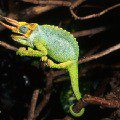 Locals call Jackson’s African chameleons “shadows of the rainforest” for their amazing “camouflage” skills. These lizards easily become invisible among the green foliage, and can also turn into a kind of knot or tree branch due to the ability to change the shape of the body so that no predator will be able to detect them. And they are also able to flatten out to look like some kind of exotic leaf. If you add to this the ability to survey space with eyes rotating in different directions without having to turn your head or make other movements, then lizards may seem simply out of reach for capture. Jackson’s chameleons always hunt from ambush, in which they can stay motionless for hours. And if they do decide to change location, they will do so by moving extremely carefully and slowly. The main hunting organ of Jackson’s chameleons is a long, muscular tongue. Lizards instantly throw it to a length, sometimes exceeding the size of their own body. At the end of this tongue is a seal, shaped like a tulip flower, and inside it is hidden a special piece of iron with a sticky substance. The caught insect sticks to it and goes into the mouth.
Locals call Jackson’s African chameleons “shadows of the rainforest” for their amazing “camouflage” skills. These lizards easily become invisible among the green foliage, and can also turn into a kind of knot or tree branch due to the ability to change the shape of the body so that no predator will be able to detect them. And they are also able to flatten out to look like some kind of exotic leaf. If you add to this the ability to survey space with eyes rotating in different directions without having to turn your head or make other movements, then lizards may seem simply out of reach for capture. Jackson’s chameleons always hunt from ambush, in which they can stay motionless for hours. And if they do decide to change location, they will do so by moving extremely carefully and slowly. The main hunting organ of Jackson’s chameleons is a long, muscular tongue. Lizards instantly throw it to a length, sometimes exceeding the size of their own body. At the end of this tongue is a seal, shaped like a tulip flower, and inside it is hidden a special piece of iron with a sticky substance. The caught insect sticks to it and goes into the mouth.
It is no coincidence that Jackson’s chameleon was given horns. With their help, males measure their strength, dividing the territory or fighting for the female. However, the smaller chameleon usually prefers to retreat. True, such fights do not imply bloodshed. It is enough that the defeated opponent falls from the branch or runs away. Male Jackson chameleons are generally territorial. They rarely approach each other less than 20 m.
Food
Feeding the Jackson chameleon is not difficult, as it is quite gluttonous and at the same time unpretentious. Flies, locusts, crickets, mealworms, grasshoppers, beetles and dragonflies are all great food for this lizard. However, you should take care of the variety of the diet, otherwise your pet will one day get used to it and start picky. So occasionally it is allowed to indulge in newborn mice. It is also important to select food according to the size of the lizard. Young animals should be given tiny fruit flies and crickets. Watering the chameleon is also necessary. Only it is unlikely that he will drink from a container or drinker, since in nature he does not use reservoirs for this. The lizard collects moisture by licking it from the leaves after rain. Therefore, the best option is to spray the terrarium with clean water a couple of times a day, creating an imitation of precipitation. Another option is to water your pet from a pipette. By the way, chameleons accustomed to this method run to her with pleasure, seeing at least a drop of water. Forced injection of lizards into the mouth is also possible, but still not recommended.
Jackson’s chameleons, like other members of the family, have an incredibly tenacious tail, which is used as a support, clothespin, and even a fifth limb. But his legs make a strange impression: they are thin and long, as if adapted for jumping or fast running. In fact, such limbs help the arboreal Jackson chameleon to easily move along the branches. If you wish, you can write a whole book about this lizard. But here we will limit ourselves to only its most characteristic features.
Reproduction
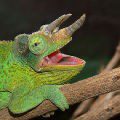 Another amazing and rather rare feature for lizards that distinguishes the Jackson chameleon is live birth. Like most other representatives of the animal world, his mating season begins with rituals. The female “puts on” a bright green outfit and allows the male to come closer. The male arranges a demonstration dance, expressed in movements reminiscent of dance steps, special nods of the head, demonstration of horns and swelling of the torso. After successful mating, the female becomes incredibly voracious and prone to fullness. She will walk pregnant from six months to 10 months. And the young are born in just a few hours, and there can be from 5 to 65 individuals in the litter. And after a couple of months, little Jackson chameleons acquire noticeable horns. In addition, the offspring must be provided with increased humidity and more vegetation, in which case its development will be successful and healthy.
Another amazing and rather rare feature for lizards that distinguishes the Jackson chameleon is live birth. Like most other representatives of the animal world, his mating season begins with rituals. The female “puts on” a bright green outfit and allows the male to come closer. The male arranges a demonstration dance, expressed in movements reminiscent of dance steps, special nods of the head, demonstration of horns and swelling of the torso. After successful mating, the female becomes incredibly voracious and prone to fullness. She will walk pregnant from six months to 10 months. And the young are born in just a few hours, and there can be from 5 to 65 individuals in the litter. And after a couple of months, little Jackson chameleons acquire noticeable horns. In addition, the offspring must be provided with increased humidity and more vegetation, in which case its development will be successful and healthy.
Sources of
http://chamaeleon.ru/
http://www.chameleons.ru/
http://www.zverki.ru/





